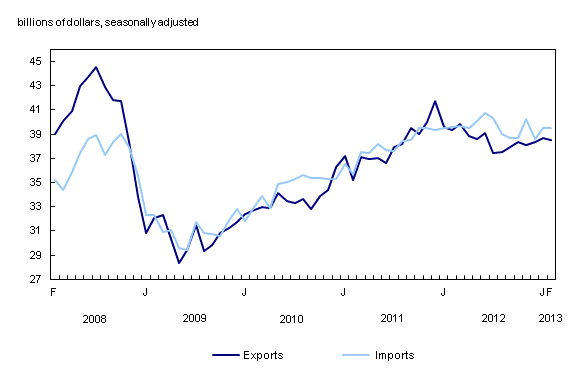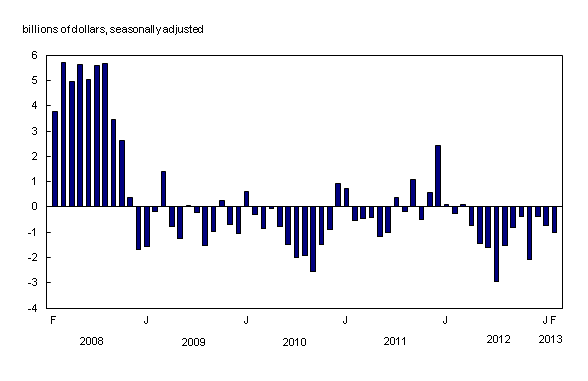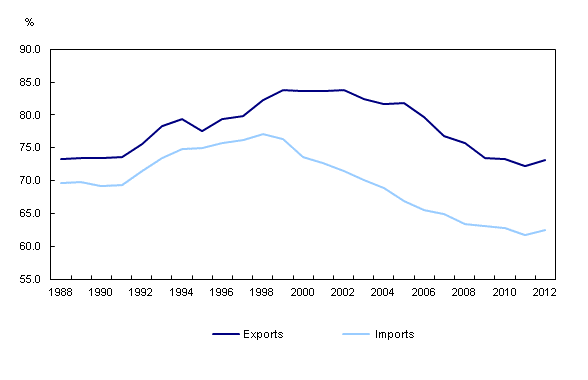Canadian international merchandise trade, February 2013
Archived Content
Information identified as archived is provided for reference, research or recordkeeping purposes. It is not subject to the Government of Canada Web Standards and has not been altered or updated since it was archived. Please "contact us" to request a format other than those available.
Released: 2013-04-05
Canada's merchandise exports decreased 0.6% in February, while imports edged up 0.1%. As a result, Canada's trade deficit with the world widened from $746 million in January to $1.0 billion in February.
Exports decreased to $38.5 billion, as volumes were down 0.6% and prices were flat. Overall, exports of metal and non-metallic mineral products contributed the most to the decline. This was partially offset by an increase in motor vehicles and parts.
Imports edged up to $39.5 billion, as prices rose 0.6% and volumes declined 0.4%. Increases in 7 of the 11 import sections were mostly offset by a large decrease of energy products.
Exports to the United States decreased 1.1% to $28.4 billion in February, while imports were up 0.8% to $25.0 billion. Consequently, Canada's trade surplus with the United States decreased from $3.9 billion in January to $3.4 billion in February.
Exports to countries other than the United States increased 0.9% to $10.1 billion. Imports declined 0.9% to $14.5 billion. As a result, Canada's trade deficit with countries other than the United States narrowed from $4.6 billion in January to $4.4 billion in February.
Metal and non-metallic mineral products section leads decline in exports
Exports of metal and non-metallic mineral products declined 7.0% to $4.7 billion in February, as prices decreased 5.9%. The main contributor to the overall decline was exports of unwrought precious metals and precious metal alloys, which fell 16.3%.
After three consecutive monthly increases, exports of basic and industrial chemical, plastic and rubber products decreased 4.3% to $2.8 billion in February. Lower volumes of dyes and pigments; petrochemicals (-23.8%) and of basic chemicals (-19.6%) led the decline. Partially offsetting these declines were higher exports of lubricants and other petroleum refinery products, which rose as a result of both higher prices and volumes.
Exports of electronic and electrical equipment declined 5.2% to $1.8 billion. Widespread decreases were recorded throughout the section, led by lower exports of communications and audio and video equipment as well as electronic and electrical parts.
Exports of motor vehicles and parts rose 5.6% to $5.4 billion, led by higher volumes of passenger cars and light trucks (+4.4%).
Rise in imports moderated by decline in energy products
Imports of motor vehicles and parts increased 5.5% to $6.8 billion in February, on higher volumes (+4.7%). The overall gain was split between passenger cars and light trucks (+6.0%), and motor vehicle engines and motor vehicle parts (+6.1%).
Imports of basic and industrial chemical, plastic and rubber products rose 10.3% to $3.4 billion. The increase was led by a 48.5% gain in volumes of lubricants and other petroleum refinery products. Also contributing to the overall gain were higher imports of basic chemicals, and of fertilizer, pesticide and other chemical products.
Widespread increases led imports of consumer goods to rise 2.3% in February to a record high of $8.0 billion. Overall, prices grew 1.3%, and volumes were up 1.0%.
Imports of energy products fell 19.3% to $3.5 billion, as a result of lower volumes (-18.7%). Imports of crude oil and crude bitumen declined 25.8% to lead the overall decrease.
Canada's merchandise trade: An annual overview of 2012
In 2012, Canada's annual merchandise imports grew at a faster pace than its exports, rising 4.2% and 1.3%, respectively.
Total imports rose to $474.5 billion, a level 7.0% higher than in 2008. Imports of motor vehicles and parts, up 11.7% to $82.8 billion in 2012, were the main contributor to the annual and four-year growth, as structural changes occurred in the automobile manufacturing industry following the downturn in 2009. Moreover, motor vehicles and parts' share of total imports reached 17.5% in 2012, compared with 16.6% in 2008 and 16.3% in 2011.
Canada's merchandise exports rose to $462.6 billion in 2012, the third consecutive annual gain. However, the total level of exports was 5.1% lower than the record high reached in 2008. In 2012, two sections, motor vehicles and parts and farm, fishing and intermediate food products, had higher export levels compared with 2008. The annual gain in motor vehicles and parts (+14.9%), was largely the result of higher exports of passenger cars and light trucks. Exports of farm, fishing and intermediate food products (+13.0%) increased as a result of favourable weather conditions in Canada, while other major exporting nations experienced drought conditions. Partially offsetting the annual increase in exports was the metal and non-metallic mineral products section, while the energy products section recorded the largest decline from 2008 to 2012.
Canada's annual trade balance with the world went from a surplus of $912 million in 2011 to a record deficit of $12.0 billion in 2012. This was the result of a lower trade surplus with Canada's largest trading partner, the United States, as well as a larger trade deficit with countries other than the United States.
Canada's trade surplus with the United States narrowed from $48.9 billion in 2011 to $42.0 billion in 2012, less than half of what was recorded in 2008. In 2012, Canada's imports from the United States gained 5.5%, while exports to the United States were up 2.6%.
In 2012, the share of Canada's exports to and imports from the United States increased to 73.2% and 62.5%, respectively. The exports' share grew for the first time in 7 years, while the imports' share rose for the first time in 14 years.
Canada's trade deficit with countries other than the United States increased for a third consecutive year, rising from $48.0 billion in 2011 to $53.9 billion in 2012. Imports from these countries rose for a third year in a row, increasing 2.0% to $178.1 billion in 2012, while exports declined 2.0% to $124.1 billion.
Note to readers
Merchandise trade is one component of Canada's international balance of payments (BOP), which also includes trade in services, investment income, current transfers as well as capital and financial flows.
International merchandise trade data by country are available on both a BOP and a customs basis for the United States, Japan and the United Kingdom. Trade data for all other individual countries are available on a customs basis only. BOP data are derived from customs data by making adjustments for factors such as valuation, coverage, timing and residency. These adjustments are made to conform to the concepts and definitions of the Canadian System of National Accounts.
Data in this release are on a BOP basis, seasonally adjusted and in current dollars. Constant dollars are calculated using the Laspeyres volume formula (2007=100).
For more information on seasonal adjustment, see Seasonal adjustment and identifying economic trends.
Revisions
In general, merchandise trade data are revised on an ongoing basis for each month of the current year. Current year revisions are reflected in both the customs and BOP based data.
The previous year's customs data are revised with the release of the January and February reference months as well as on a quarterly basis. The previous two years of customs based data are revised annually and are released in February with the December reference month.
The previous year's BOP based data are revised with the release of the January, February and March reference months. Revisions to BOP based data for the previous three years are released annually in June with the April reference month.
Factors influencing revisions include late receipt of import and export documentation, incorrect information on customs forms, replacement of estimates produced for the energy section with actual figures, changes in classification of merchandise based on more current information, and changes to seasonal adjustment factors.
Revised data are available in the appropriate CANSIM tables.
These data are now available in the Canadian International Merchandise Trade Database (Catalogue number65F0013X). From the Browse by key resource module of our website, choose Publications.
The February 2013 issue of Canadian International Merchandise Trade, Vol. 67, no. 2 (Catalogue number65-001-X), is also available from the Browse by key resource module of our website under Publications.
Current account data (which incorporate merchandise trade statistics, service transactions, investment income and transfers) are available quarterly in Canada's Balance of International Payments (Catalogue number67-001-X).
Data on Canadian international merchandise trade for March will be released on May 2.
Contact information
For more information, contact us (toll-free 1-800-263-1136; infostats@statcan.gc.ca).
To enquire about the concepts, methods or data quality of this release, contact Marc Nadeau (613-951-3692), International Trade Division.
- Date modified:




